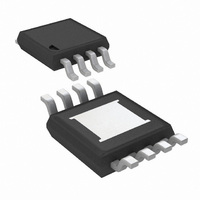LM3405AXMY/NOPB National Semiconductor, LM3405AXMY/NOPB Datasheet - Page 9

LM3405AXMY/NOPB
Manufacturer Part Number
LM3405AXMY/NOPB
Description
IC LED DRVR HP CONST CURR 8-MSOP
Manufacturer
National Semiconductor
Series
PowerWise®r
Type
High Power, Constant Currentr
Datasheet
1.LM3405AXMKNOPB.pdf
(20 pages)
Specifications of LM3405AXMY/NOPB
Constant Current
Yes
Topology
PWM, Step-Down (Buck)
Number Of Outputs
1
Internal Driver
Yes
Type - Primary
Flash/Torch
Type - Secondary
High Brightness LED (HBLED), White LED
Frequency
1.2MHz ~ 1.9MHz
Voltage - Supply
3 V ~ 22 V
Mounting Type
Surface Mount
Package / Case
8-MSOP Exposed Pad, 8-HMSOP, 8-eMSOP
Operating Temperature
-40°C ~ 125°C
Current - Output / Channel
1A
Internal Switch(s)
Yes
Efficiency
92%
Lead Free Status / RoHS Status
Lead free / RoHS Compliant
Voltage - Output
-
Other names
LM3405AXMYTR
LED PWM DIMMING
The LED brightness can be controlled by applying a periodic
pulse signal to the EN/DIM pin and varying its frequency and/
or duty cycle. This so-called PWM dimming method controls
the average light output by pulsing the LED current between
the set value and zero. A logic high level at the EN/DIM pin
turns on the LED current whereas a logic low level turns off
the LED current. Figure 9 shows a typical LED current wave-
form in PWM dimming mode. As explained in the previous
section, there is approximately a 100µs delay from the EN/
DIM signal going high to fully establishing the LED current as
shown in Figure 10. This 100µs delay sets a maximum fre-
quency limit for the driving signal that can be applied to the
EN/DIM pin for PWM dimming. Figure 11 shows the average
LED current versus duty cycle of PWM dimming signal for
various frequencies. The applicable frequency range to drive
LM3405A for PWM dimming is from 100Hz to 5kHz. The dim-
ming ratio reduces drastically when the applied PWM dim-
ming frequency is greater than 5kHz.
FIGURE 9. PWM Dimming of LEDs using the EN/DIM Pin
FIGURE 10. Startup Response to EN/DIM with I
30015266
30015267
F
= 1A
9
UNDER-VOLTAGE LOCKOUT
Under-voltage lockout (UVLO) prevents the LM3405A from
operating until the input voltage exceeds 2.74V (typical). The
UVLO threshold has approximately 440mV of hysteresis, so
the part will operate until V
teresis prevents the part from turning off during power up if
V
CURRENT LIMIT
The LM3405A uses cycle-by-cycle current limit to protect the
internal power switch. During each switching cycle, a current
limit comparator detects if the power switch current exceeds
2.0A (typical), and turns off the switch until the next switching
cycle begins.
OVER-CURRENT PROTECTION
The LM3405A has a built in over-current comparator that
compares the FB pin voltage to a threshold voltage that is
60% higher than the internal reference V
voltage exceeds this threshold level (typically 328mV), the in-
ternal NMOS power switch is turned off, which allows the
feedback voltage to decrease towards regulation. This
threshold provides an upper limit for the LED current. LED
current overshoot is limited to 328mV/R1 by this comparator
during transients.
THERMAL SHUTDOWN
Thermal shutdown limits total power dissipation by turning off
the internal power switch when the IC junction temperature
exceeds 165°C. After thermal shutdown occurs, the power
switch does not turn on until the junction temperature drops
below approximately 150°C.
Design Guide
INDUCTOR (L1)
The Duty Cycle (D) can be approximated quickly using the
ratio of output voltage (V
FIGURE 11. Average LED Current versus Duty Cycle of
IN
is non-monotonic.
PWM Dimming Signal at EN/DIM Pin
OUT
IN
) to input voltage (V
drops below 2.3V (typical). Hys-
REF
. Once the FB pin
IN
www.national.com
30015283
):










